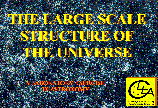

 |
Required SoftwareThis is a zip file that contains an .exe file that will install itself when you run it on your computer.
Print up this Wall-size Wedge plot to use with your students as an alternate to the networked display program. You can have students put push-pins into it, or write on it with markers. Courtesy of Dr. Michael Merrifield, School of Physics & Astronomy, University of Nottingham, England. |
||
| Purpose: To understand how astronomers
use the redshift-distance relation to map out the cosmic structure of the
galaxies. To discover how the galaxies in the vicinity of the Milky Way
are distributed in space. To understand how astronomers work together to
collect data on many objects.
In this lab students use a computer simulation of a telescope equipped with a photon-counting spectrophotometer to take spectra of galaxies. (The equipment is similar to that in the Hubble Redshift-Distance experiment.) They can measure the wavelength of prominent absorption lines determine the redshifts, and store data on disk, import it into spreadsheets, or print it out. Using the spectrometer, students obtain spectra of 218 galaxies selected from the Harvard-Smithsonian Center for Astrophysics Redshift Survey. They plot the redshifts versus celestial coordinate to produce a "wedge diagram" which represents the distribution of galaxies in space around the Milky Way. The exercise can be done by a single student as a long-term project, or can be done by a classroom as a collaborative project, with each lab table taking a subset of the sample and contributing redshifts to a group plot. Students plot their wedge diagrams using a networked computer program that accepts data from each table. The program can also be used on single machines. Alternately, special polar plotting paper is provided so that classes can plot the data by hand. The software contains options for students to select one of three telescopes. Real galaxy images and star fields selected from the Hubble Guide Star Catalog add to the realism of the simulation. |